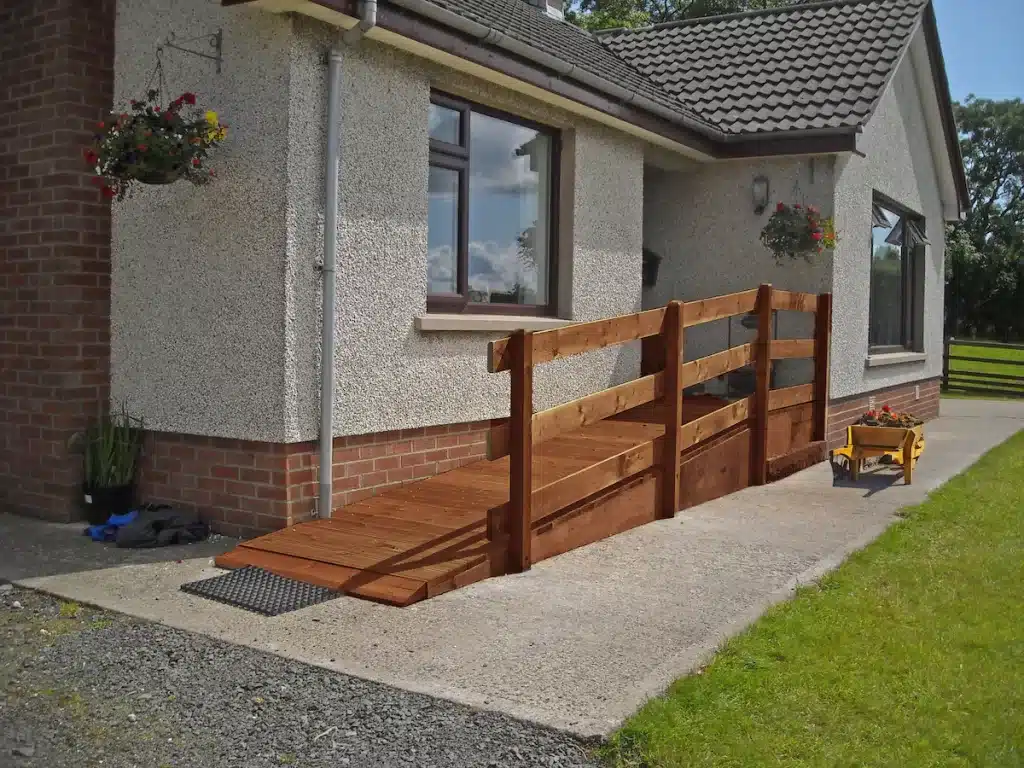Accessible homes are intended to offer independent living to people who have a disability or use a wheelchair, walker, or other mobility device. More and more, new construction is incorporating principles of universal design, with the goal of making sure everyone can use a space safely and effectively, regardless of age or ability.
But not everyone has the resources to move to a new home or build one from the ground up. In that case, the next best option is renovating your home — or your investment property, if you have tenants with disabilities — to add upgrades that make the property more convenient for those with mobility limitations.

Consider the following ways to create a more accessible home for yourself, loved ones, or visitors.
Installing a ramp to give easier access in and out of your home for those in a wheelchair is one of the best ways to make your house more accessible. Ramps can be permanent or portable, whichever works best for your needs.
A permanent metal or wooden ramp must be professionally installed and may require permits, but it can be a good long-term option. More portable options include threshold ramps that can be used to level the height difference between the outside and inside up to 6 inches. Portable bifold or trifold ramps are good short-term options that provide the same accessibility without installing a more permanent structure.
Ideally, doors should be 32 to 36 inches wide to comfortably accommodate wheelchairs and walkers. In reality, most residential doorways are 23 to 30 inches wide.
You may be able to add an inch or two by removing the door and possibly the trim, or installing offset or expandable door hinges. If your door frame is closer to 23 inches — common in vintage homes — you may need to consider expanding the door frame altogether to make it accessible. Be sure to get estimates from different contractors because renovation costs are one of the largest expenses of owning a home.
For people with limited mobility, the bathroom can be particularly hazardous. According to the Centers for Disease Control and Prevention, almost 80% of all bathroom injuries are caused by falls, with higher injury rates among older adults.
If you’re planning a full bathroom renovation, it’s a good time to consider universal design elements you can incorporate as part of the remodel. Even if you’re not overhauling a bathroom, the following adjustments are easy and relatively inexpensive to make:
Add a seat in the shower: Shower chairs come in all shapes and sizes for different needs, from stools to chairs with a back and arm grips. Movable chairs offer portability, while a flip-down shower seat installed on a shower wall offers more security and stores out of the way when the shower is used by other members of the household.
Install grab bars: Installing grab bars near the toilet and in the shower is an inexpensive and easy way to add additional support for those with strength, mobility, or balance issues. For someone recovering from an injury or surgery, you might consider a position pole, a floor-to-ceiling support bar that can be temporarily installed anywhere someone may need assistance, including near a toilet, shower, bed, or chair. A position pole works on the same principle as a tension rod, in that it exerts pressure as it expands.
Switch out fixtures to levers: Replace older knob or pull-out faucets with single-lever fixtures that can be turned on or off with an open palm or closed fist. Motion-sensing fixtures will turn water on or off with the swipe of a hand. Fixtures should be clearly labeled with blue or red indicators. Anti-scald valves installed in the shower/tub can help to prevent burns by regulating the mix of hot and cold water.
Navigating tight turns around pieces of furniture can be a frustrating challenge for someone who uses a mobility aid, such as a wheelchair or walker. From a design standpoint, the minimum amount of space typically recommended between pieces of furniture is 36 inches. Consider adding an additional 6 inches when arranging furniture to accommodate a loved one who is mobility-impaired. Wheelchairs typically need a 5-foot radius to maneuver safely, ideally through spaces without sharp corners.
Removing tripping and slipping hazards from the home can help prevent falls and other accidents. Loose floor coverings like area rugs, kitchen mats, doormats, and bathroom rugs can be a challenge. Large area rugs, such as those with tassels, can be removed, and bath, kitchen, and doorway mats should be heavy, with a rubberized backing to prevent slipping. If it’s in your budget, consider low-pile carpeting for bedrooms, living rooms, and dens.
Lamp, computer, and TV cords should be bundled out of the way. On stairways, install handrails on both sides, and add nonslip surfaces to stairs if possible.
More than ever, technology is making it easier to create accessible homes. Voice- or remote-controlled washers and dryers, ovens, heating and cooling systems, lights, TVs, and window blinds allow residents to control their environment with the touch of a button or the sound of their voice.
Video doorbells can provide an added layer of safety, allowing anyone to see and speak to someone at the door without having to actually open the door. Those experiencing hearing loss can set their smartphone to notify them when the doorbell rings.
Integrating smart technology into your home can also pay off down the road if you opt to sell, as more home buyers now consider smart features to be standard practice.
Creating an accessible living environment can be a challenge, whether you’re making small adjustments or undertaking a significant remodel. But it’s important that all members of the household feel safe, secure, and comfortable in their own home, with the ability to age in place for as long as possible, recover from a health challenge, or live with a disability.